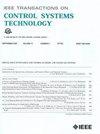Koopman System Approximation-Based Optimal Control of Multiple Mobile Robots
IF 3.9
2区 计算机科学
Q1 AUTOMATION & CONTROL SYSTEMS
引用次数: 0
Abstract
This article presents a study of the Koopman operator theory and its application to optimal control of a multiple-mobile-robot system. The operator, while operating on a set of observation functions of the state vector of a nonlinear system, produces a set of dynamic equations that, through a dynamic transformation, form a new dynamic system. The Koopman system technique is then applied to the development of a linear or bilinear model approximation of nonlinear utility functions for optimal control of a system of multiple (mobile) robots, by selecting the utility functions as the Koopman system state variables and expressing the set of Koopman variables as the state variables of a linear or bilinear system whose parameters are determined through optimization. An iterative algorithm is developed to estimate the parameters adaptively. Finally, the optimal control problems based on a linear or bilinear approximation model are formulated, by transforming the nonlinear programming problem to a linear programming problem. The above models are simulated on a three-mobile-robot system to verify their performance in both centralized and decentralized versions. From the simulation results, the bilinear model has more capacity to approximate the nonlinear utility functions. Both the centralized and decentralized bilinear approximation model-based control signals can achieve the control objective and are generated fast enough for real-time control.基于Koopman系统近似的多移动机器人最优控制
本文研究了库普曼算子理论及其在多移动机器人系统最优控制中的应用。算子在作用于非线性系统状态向量的一组观测函数时,产生一组动态方程,通过动态变换,形成一个新的动态系统。然后,通过选择效用函数作为库普曼系统状态变量,并将库普曼变量集表示为通过优化确定参数的线性或双线性系统的状态变量,将库普曼系统技术应用于开发非线性效用函数的线性或双线性模型近似,以实现多(移动)机器人系统的最优控制。提出了一种自适应估计参数的迭代算法。最后,将非线性规划问题转化为线性规划问题,建立了基于线性或双线性逼近模型的最优控制问题。在一个三移动机器人系统上对上述模型进行了仿真,以验证其在集中式和分散式两种版本下的性能。仿真结果表明,双线性模型具有更强的近似非线性效用函数的能力。基于集中式和分散式双线性逼近模型的控制信号都能达到控制目标,且生成速度快,可以实现实时控制。
本文章由计算机程序翻译,如有差异,请以英文原文为准。
求助全文
约1分钟内获得全文
求助全文
来源期刊

IEEE Transactions on Control Systems Technology
工程技术-工程:电子与电气
CiteScore
10.70
自引率
2.10%
发文量
218
审稿时长
6.7 months
期刊介绍:
The IEEE Transactions on Control Systems Technology publishes high quality technical papers on technological advances in control engineering. The word technology is from the Greek technologia. The modern meaning is a scientific method to achieve a practical purpose. Control Systems Technology includes all aspects of control engineering needed to implement practical control systems, from analysis and design, through simulation and hardware. A primary purpose of the IEEE Transactions on Control Systems Technology is to have an archival publication which will bridge the gap between theory and practice. Papers are published in the IEEE Transactions on Control System Technology which disclose significant new knowledge, exploratory developments, or practical applications in all aspects of technology needed to implement control systems, from analysis and design through simulation, and hardware.
 求助内容:
求助内容: 应助结果提醒方式:
应助结果提醒方式:


